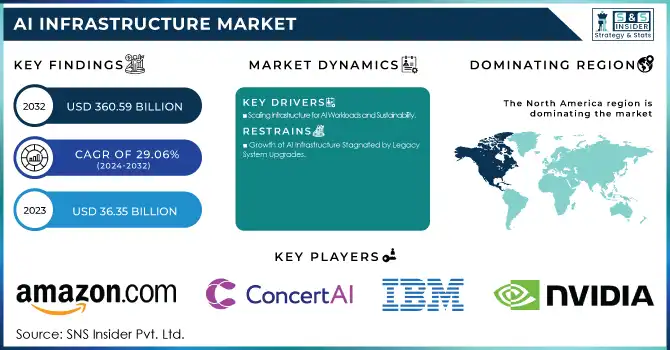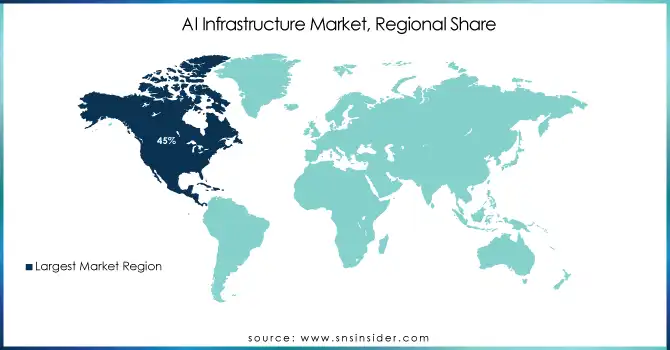AI Infrastructure Market Size & Trends:
The AI Infrastructure Market Size was valued at USD 36.35 billion in 2023 and is expected to reach USD 360.59 billion by 2032 and grow at a CAGR of 29.06% over the forecast period 2024-2032.
The demand for high-performance computing to manage complex AI workloads and the rise in generative AI (GenAI) applications, including large language models, is driving this growth. These models require immense computational power for both training and inference. Cloud service providers are increasingly adopting AI infrastructure to offer scalable and cost-effective solutions, further fueling market expansion. Factors such as regional adoption rates, energy consumption and efficiency metrics, regulatory compliance, and ongoing innovation in R&D also contribute to the market's momentum.

Get more information on AI Infrastructure Market - Request Sample Report
AI Infrastructure Market Dynamics
Drivers:
-
Scaling Infrastructure for AI Workloads and Sustainability
The increasing adoption of generative AI is sensitive to the AI infrastructure market; around 65% of organizations have adopted AI models independently or with help from external experts. Because of this increased demand, 40% of operators who run data centers plan to increase capacity with infrastructure upgrades and construction. 41% of operators are bringing renewable energy directly onto their organizations and balancing immediate demands with their sustainability goals, while 38% are using energy management platforms for optimal energy operations. These factors together propel the market growth and increase the scalability & efficiency of AI infrastructure.
Restraints
-
Growth of AI Infrastructure Stagnated by Legacy System Upgrades
One key holding back the growth of the AI infrastructure market is the difficulty of migrating from legacy systems that are embedded in mission-critical operations. Legacy infrastructure are expensive and complex to upgrade for AI optimised platforms due to their basic compute, storage and flexibility restrictions. It affects the continuity of the business and it in turn slows the adoption of AI. In addition, our appetite for AI is stressing data centers, which are projected to use 9% of the nation electricity by 2030. Big investments are in store from companies such as Microsoft to address these increasing energy and infrastructure demands.
Opportunities:
-
Expanding Market for Scalable and Sustainable AI Infrastructure
The AI infrastructure market has enormous potential due to the increasing demand for AI-powered solutions. For instance, Nvidia has made strides in memory solutions and scalable AI networks, while Micron has amassed big investments, and DDN has benefits from this growth. The growth in AI workloads, expansion of data centers, and the integration of renewable energy, are becoming the bread and butter for AI infrastructure, evolving this market into one of the most exciting places for innovation in the space. This has led to strategic partnerships such as that of Hammerspace and MinIO, which allows players in the market to take advantage of increased functionality and revenue in AI driven ecosystems.
Challenges
-
Scalability Challenges in AI Infrastructure Amid Growing Demand for High-Performance Solutions
Implementing scalable AI infrastructure AI infrastructure scalability refers to the capability of an AI infrastructure to accommodate the fastest growing AI workloads and data. Microsoft, amongst others, are pouring their money towards this, towards a USD 30 billion infrastructure fund to cement vertical integration of AI in place. The increasing need for computational capacity in AI is stretching data centers, and the growing requirement for purpose-built hardware to scale AI workloads. Systems must be able to scale denser as the number of AI workloads doubles and reallocate resources and data more dynamically in order to address the growing demand for computational power and data management.
AI Infrastructure Market Segmentation Analysis:
By Offering
Hardware became 62% of the AI infrastructure market, in 2023, driven by the demand for higher-performing systems for AI workloads. The USA is catching a hold of scaling the AI hardware position to area quick getting the high ground of the AI framework, the area additionally has the godsend of AI research, Cloud Computing, and so on.
The software segment to grow fastest over 2024 – 2032. Topping all global rankings for cloud computing and software development, North America has been outspent by China and Japan on investments to advance machine learning and AI technologies.
By Deployment
The cloud segment dominated of around 46% revenue share in AI infrastructure market in 2023, due to the increase in needs for scalable and flexible AI solutions that have been deployed on cloud based AI infrastructure. Essentially, how much cloud infrastructure the U.S. and Europe are building is going to help the AI Innovation.
The hybrid segment was the fastest-growing and is expected to continue growing between 2024 and 2032 benefiting from its balance of cloud versatility and on premise protection. A balance between data private and innovation, hybrid cloud benefits both, and the top 4 nations are - U.S., Germany, India and, China.
By Technology
In 2023, the machine-learning segment dominated the AI infrastructure market, comprising about 75% of the share, largely because machine learning gaining traction, especially in healthcare, finance, e-commerce, and retail industries. As automation and predictive analytics surge, the demand for resilient AI infrastructure has increased with investments
The deep learning segment to grow rapidly from 2024 to 2032, including healthcare, automotive, and finance, with North America and Asia-Pacific’s investments in the technology.
By End Use
In 2023, cloud service providers held around 50% of the AI infrastructure market, driven by the growing demand for scalable, flexible solutions. The U.S., China, and India are investing in expanding their cloud infrastructures to enhance AI capabilities.
The Enterprise Segment is the fastest growing in Ai Infrastructure Market through 2024 to 2032 where the growing adoption of AI based solutions across enterprises for automation, data processing and decision-making will augment the growth.
AI Infrastructure Market Regional Insights
North America dominated the AI infrastructure industry, holding approximately 45% of global revenue due to substantial investments from leading technology firms. The United States particularly stands out, with giants such as Google, Microsoft, and Amazon pouring vast resources into AI infrastructure development. Alongside robust research capabilities and widespread cloud adoption, these heavy investments have allowed the region to cement its position as the foremost leader in AI worldwide.
Asia Pacific has emerged as the most rapidly expanding region for AI infrastructure. Across countries like China, Japan, and India, substantial public and private investments are powering intense growth in AI research and development. In China, state initiatives focus on constructing advanced computing infrastructure and cloud platforms to elevate AI capabilities. Simultaneously, India looks increasingly to AI technologies to modernize core industries like manufacturing and finance. Japan meanwhile directs attention towards robotics and automotive applications. Spurred by explosive technological adoption, burgeoning demand for scalable solutions, and government support, Asia Pacific has risen to become a pivotal hub within the global AI infrastructure industry.

Get Customized Report as per your Business Requirement - Request For Customized Report
Key Players
Some of the Major Player in AI Infrastructure Market Along With Their Products
-
Nvidia Corporation (U.S.) - (AI Hardware, GPUs)
-
AIBrain (U.S.) - (AI-based software solutions)
-
IBM Corporation (U.S.) - (AI software, Watson AI)
-
ConcertAI (U.S.) - (AI for healthcare, data analytics)
-
Oracle Corporation (U.S.) - (AI and cloud solutions)
-
Salesforce, Inc. (U.S.) - (AI-powered CRM solutions)
-
Amazon.com, Inc. (U.S.) - (AWS AI, cloud services)
-
Google LLC (Alphabet Inc.) (U.S.) - (Google AI, TensorFlow)
-
Super Micro Computers, Inc. (U.S.) - (AI hardware, servers)
-
Intel Corporation (U.S.) - (AI chips, processors)
-
Microsoft (U.S.) - (Azure AI, cloud AI solutions)
-
Baidu (China) - (AI software, cloud services)
-
Huawei Technologies (China) - (AI hardware, cloud solutions)
-
Samsung Electronics (South Korea) - (AI chips, devices)
List of companies that provide raw materials and components for the AI infrastructure market:
-
TSMC (Taiwan)
-
AMD (U.S.)
-
Micron Technology (U.S.)
-
Broadcom (U.S.)
-
Samsung Electronics (South Korea)
-
Intel Corporation (U.S.)
-
Nvidia Corporation (U.S.)
-
Qualcomm (U.S.)
-
SK Hynix (South Korea)
-
Texas Instruments (U.S.)
Recent Development
-
4 February 2025, Nvidia as the pioneering graphics company reshaped its focus toward artificial intelligence applications and services. In a strategic drive to stimulate widespread innovation across industries, Nvidia forged lucrative partnerships with Amazon Web Services and Microsoft Azure.
-
August 29, 2024: Intel announced a collaborative endeavor with IBM that would deploy Intel's cutting-edge Gaudi 3 AI accelerators on the IBM Cloud platform starting in early 2025. This alliance aimed to provide enterprises with more cost-effective scaling of their AI workloads through enhanced performance delivered by Gaudi 3's seamless integration with Xeon CPUs. The solution sought to simultaneously optimize efficiency for deploying AI in the cloud and data centers while reducing total costs of ownership for businesses.
| Report Attributes | Details |
| Market Size in 2023 | USD 36.35 Billion |
| Market Size by 2032 | USD 360.59 Billion |
| CAGR | CAGR of 29.06% From 2024 to 2032 |
| Base Year | 2023 |
| Forecast Period | 2024-2032 |
| Historical Data | 2020-2022 |
| Report Scope & Coverage | Market Size, Segments Analysis, Competitive Landscape, Regional Analysis, DROC & SWOT Analysis, Forecast Outlook |
| Key Segments | • by Offering (Hardware [Processor, Storage, Memory], Software) • By Deployment (On-Premises, Cloud, Hybrid) • By Technology (Machine Learning, Deep Learning) • By End Use (Enterprise, Government Organization, Cloud Services Providers) |
| Regional Analysis/Coverage | North America (US, Canada, Mexico), Europe (Eastern Europe [Poland, Romania, Hungary, Turkey, Rest of Eastern Europe] Western Europe] Germany, France, UK, Italy, Spain, Netherlands, Switzerland, Austria, Rest of Western Europe]), Asia Pacific (China, India, Japan, South Korea, Vietnam, Singapore, Australia, Rest of Asia Pacific), Middle East & Africa (Middle East [UAE, Egypt, Saudi Arabia, Qatar, Rest of Middle East], Africa [Nigeria, South Africa, Rest of Africa], Latin America (Brazil, Argentina, Colombia, Rest of Latin America) |
| Company Profiles | Nvidia Corporation (U.S.), AIBrain (U.S.), IBM Corporation (U.S.), ConcertAI (U.S.), Oracle Corporation (U.S.), Salesforce, Inc. (U.S.), Amazon.com, Inc. (U.S.), Google LLC (U.S.), Super Micro Computers, Inc. (U.S.), Intel Corporation (U.S.), Microsoft (U.S.), Baidu (China), Huawei Technologies (China), and Samsung Electronics (South Korea) are key players in the AI infrastructure market, offering a range of AI solutions spanning hardware, software, cloud, and analytics. |

